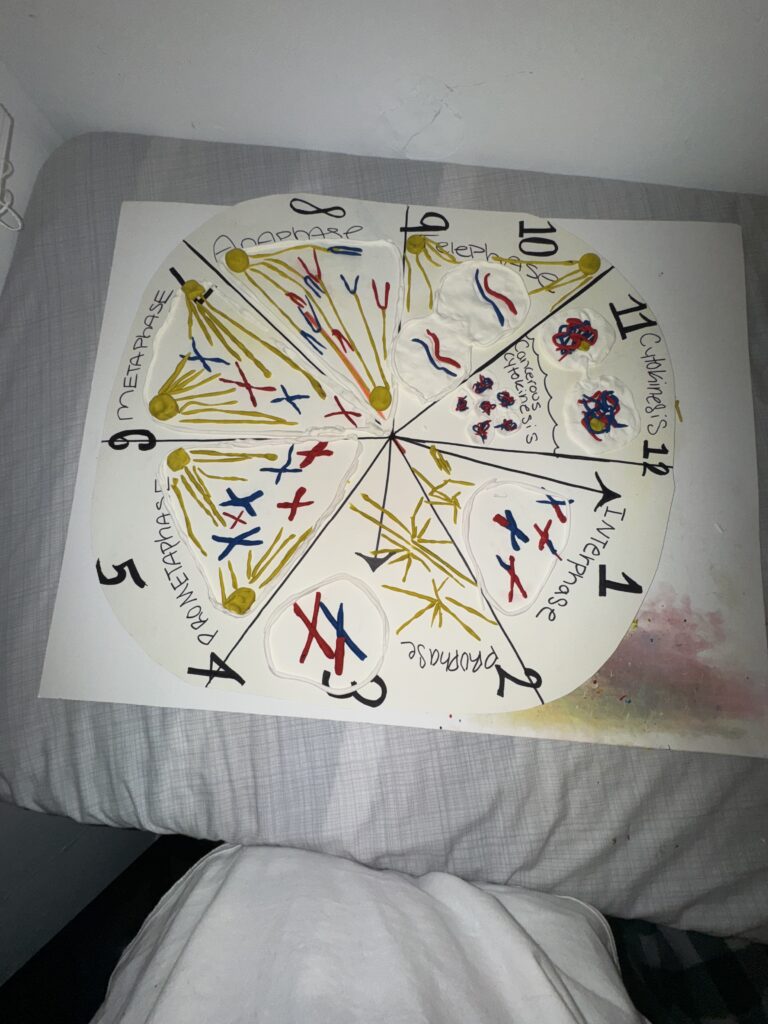By Liberty Bryant

PROJECT DESCRIPTION:
My project goes through the process of mitosis and specifically cytokinesis, showing how these very important mechanisms of cell division can lead to cancer when they go wrong. Mitosis is the foundation of growth and repair in the body, dividing one parent cell into two identical daughter cells. My project highlights each stage of mitosis : prophase, prometaphase, metaphase, anaphase, and telophase and cytokinesis using a clock-like design to visually explain the sequence and function of these phases. Cytokinesis, the final step in cell division, ensures that the cytoplasm is evenly split which is supposed to create only two independent cells.The stages of mitosis are represented in detail. In prophase, the chromosomes condense and the nuclear envelope dissolves, preparing for division. Prometaphase introduces the spindle fibers, which attach to chromosomes at their kinetochores. In metaphase, the chromosomes align in the middle of the cell, ensuring an equal distribution during division. Anaphase separates the sister chromatids, pulling them to opposite ends of the cell. Telophase wraps up the process by reforming the nuclear envelope and decondensing the chromosomes. Cytokinesis occurs after telophase, dividing the cytoplasm and completing the creation of two genetically identical cells.However, errors in mitosis or cytokinesis can have devastating consequences, including the development of cancer. When cytokinesis fails, cells may become tetraploid which means that they have double the normal chromosome number. These cells are more likely to experience “genetic instability” , which increases the risk of accumulating mutations that lead to cancer in the future. For example, disruptions in the protein “CIT-K”, which is essential for cytokinesis, can cause cells to bypass and not go through the normal division controls, further driving and leading to tumor growth, whether cancerous or benign.The connection between cytokinesis failure and cancer is an important focus of My project. Cancer is essentially unchecked cell division, which often results from mutations in genes that are supposed to regulate the cell cycle. “Proto oncogenes” and tumor suppressor genes are important in this process, not mentioned in my project but when protooncogenes are functioning correctly, they help regulate cell division in a healthy way. However, if a proto oncogene becomes mutated or overly active, it can transform into an oncogene, which can turn into uncontrolled cell division. This means that instead of dividing only when needed, the cell starts dividing excessively. The tumor suppressor genes are there to put on the brakes and stop this from happening. Mutations in these genes upset the balance, leading to the uncontrolled proliferation of cancer cells. External factors like radiation, UV exposure, and carcinogens also increase the risk of these mutations, which shows just how environmental and genetic factors interact to cause cancer.The project looks at how cancer cells can change and adapt. Even though targeting certain proteins, like CIT-K, to stop cell division is a good treatment idea, cancer cells often find ways to avoid this. This ability to adapt makes cancer hard to treat. By understanding how cell division works in cancer, scientists can learn better ways to stop it by tackling the problem at its source which is those cells dividing uncontrollably. The visual layout of this project makes these complex ideas more easily understandable. By presenting mitosis as a clock, it emphasizes the order and precision of each phase while connecting the process to the potential for errors and diseases. This combination of scientific explanation and creative design effectively bridges the gap between biology and art, making it easier to understand how something as routine as cell division can have life-altering consequences when it goes wrong. This project not only illustrates the intricate process of mitosis and cytokinesis but also highlights the critical role these mechanisms play in maintaining healthy cell division. By visualizing the stages of mitosis as a clock, I’ve made these complex biological concepts more accessible, emphasizing the precision and order required for normal cell function. However, when errors occur in these processes, such as cytokinesis failure, they can lead to serious consequences like cancer. Understanding how these errors happen and how cells adapt to bypass normal controls is essential in developing new treatments. By merging scientific explanation with creative design, this project helps bridge the gap between biology and art
I am currently out of town and did not have time to give proper explanations on each phase on my poster before I left so I am going to list them here 🙂
INTERPHASE: The cell grows and carries out all normal metabolic functions and processes in a period called gap 1 phase, which is the first gap, or growth phase in the cell cycle. For cells that will divide again, gap 1 phase is followed by replication of the DNA during the synthesis phase. After the synthesis phase, the cell proceeds through a second gap phase in which the cell continues to grow and makes the necessary preparations for mitosis.
PROPHASE: The first phase of mitosis is when the loosely packed chromatin coils and condenses into visible chromosomes. Each chromosome has an identical partner attached, forming a X-shape of sister chromatids. The nucleolus disappears early during this phase, and the nuclear envelope also disintegrates/disappears.
PROMETAPHASE: Microtubules from the mitotic spindle invade the nuclear area. The nuclear membrane disintegrates, and microtubules attach to the centromeres that adjoin pairs of sister chromatids. The kinetochore is a protein structure on the centromere that serves as the point of attachment between the mitotic spindle and the sister chromatids.
METAPHASE: The sister chromatids, attached to microtubules, are lined up at the metaphase plate, which is the center of the cell. This is a crucial stop and go checkpoint in metaphase ensures that the cell is fully prepared to complete cell division. This checkpoint makes sure all sister chromatids are properly attached to their respective microtubules and lined up at the metaphase plate before the signal is given to separate them during anaphase
.
ANAPHASE: The pairs of sister chromatids are separated, forming individual chromosomes once again. These chromosomes are pulled to opposite ends of the cell by their kinetochores, as the microtubules shorten. Each end of the cell receives one partner from each pair of sister chromatids, ensuring that the two new daughter cells will contain identical genetic material.
TELOPHASE: Two new daughter nuclei are formed at either end of the dividing cell. These newly formed nuclei surround the genetic material, which uncoils such that the chromosomes return to loosely packed chromatin. Nucleoli also reappear within the new nuclei, and the mitotic spindle breaks apart, each new cell receiving its own complement of DNA, organelles, membranes, and centrioles.
CYTOKINESIS: The cytoplasm and cell body are divided into two new cells.
CANCEROUS CYTOKINESIS: One key error in cancerous cells is cytokinesis failure, where cells replicate their DNA and grow but fail to divide their cytoplasm. This results in multinucleated cells, a hallmark of many tumors. Cancer is tied into this by the accumulation of those DNA mutations that allow cells to escape the normal control mechanisms that regulate cell division. “Healthy cells” rely on a balanced network of molecular signals, such as proto-oncogenes, tumor suppressor genes, and checkpoint proteins, to ensure that the cell division occurs only when necessary. When this balance is disrupted, cells can start separating and multiplying uncontrollably, leading to cancer.
CITATIONS
1. 3.5 Cell Growth and Division – Anatomy and Physiology 2e | OpenStax. (n.d.). Openstax.org. https://openstax.org/books/anatomy-and-physiology-2e/pages/3-5-cell-growth-and-division
2. Miettinen, T. P., Kang, J. H., Yang, L. F., & Manalis, S. R. (2019). Mammalian cell growth dynamics in mitosis. ELife, 8, e44700. https://doi.org/10.7554/eLife.44700Sechi
3. S., Piergentili, R., & Giansanti, M. G. (2022). Minor kinases with major roles in cytokinesis regulation. Cells, 11(22), 3639. https://doi.org/10.3390/cells11223639

